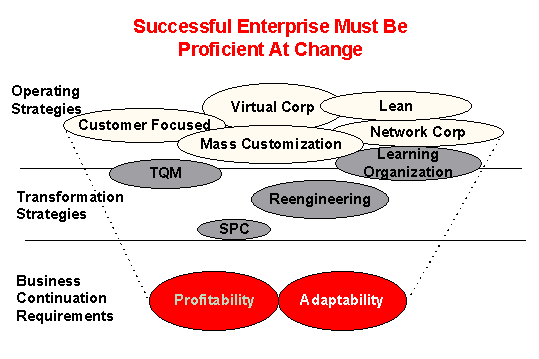Rick Dove, Paradigm Shift
International, www.parshift.com, ![]()
Agility is a very seductive word. One that finds immediate and personal definition for almost everyone. It can capture cycle time reduction -- with everything faster. It can encompass mass customization -- with customer responsiveness. It can embrace virtual enterprise -- with streamlined supplier networks and joint ventures. It can echo reengineering -- with continual process transformation. It can demand a learning organization -- with systemic training and education. It can build on Lean production -- with high resource productivity.
As a descriptive word, Agility can embrace almost any of our current competitiveness interests with considerable intuitive appeal.
Agility is presented by some as an amplification of one of these concepts, and by some others as a superset of many. Casual investigation of Agility can easily lead to greater fuzziness as a greater number of sources are heard from.
Confusion is evidenced in many ways. Some people ask for the difference between Agile and Lean, Agile and TQM, Agile and Mass Customization. Others say that Agility is their next priority after completing their transformation to Lean production, or whatever else they are currently embarked upon.
It is time to crystallize the understanding of this very useful and important concept.
Agility was born in 1991 when an industry group observed that the increasing rate of change in the business environment was outpacing the adaptability of traditional manufacturing organizations. Dominant organizations were suddenly failing when continuously changing markets and customer interests found new sources of satisfaction.
Though some of these organizations were simply late to wake up, many could see a need but were unable to institute internal change quick enough.
Agility is the word that describes the missing characteristic in these organizations. They could not adapt at the same pace as their changing environment - neither to counter a threat nor take advantage of a major opportunity.
This adaptability idea for organizations is not anything new, however. Organizations have always existed in a changing environment and have always had to adapt -- ever since the first humans banded together for purpose.
Organizational adaptability is a core viability requirement -- just like profitability. In order to continue as a viable entity an organization must meet two conditions for existence: it must satisfy some purpose (profitability) and it must continuously adapt as necessary to changing
In the life metaphor we talk about evolution and mutation as ways to accommodate a changing environment. We look for the mechanics of this characteristic in the genome of life. Equivalently in the organization we must look to see how the organization is organized -- both statically and dynamically.
To mix metaphors, Agility is a plumbing issue first and foremost. Operating strategies like lean production, and transformation strategies like process reengineering are all facilitated by an underlying proficiency at change. If the organization is "proficient" at change it can and will adapt to take advantage of unpredictable opportunity as well as counter the unpredictable threat.
Being Agile means being proficient at change -- and allows an organization to do anything it wants to do whenever it wants to. Thus, an Agile organization can employ business process reengineering as a core competency when transformation is called for. It can hasten its conversion to Lean production while that is still useful. And importantly, it can continue to succeed when constant innovation becomes the dominate competitive strategy.
Trying to differentiate mass customization or Lean from Agile miscasts all as operating strategies. And asking for the differences between TQM and Agile misclasses both as transformation strategies.
Holding off Agile programs until a transformation to Lean production is completed incorrectly assumes that these are sequentially dependent concepts. Rather than close the barn door after the horse has left, a transformation to Lean production will happen faster and with less expense as the organization becomes more Agile.
Agility is a core fundamental requirement of all organizations. It was not interesting as a focused concept when environmental change was relatively slow and predictable. Now it gains considerable attention and a growing number of proponents.
Confusion in this early stage of understanding is introduced principally from two sources: indiscriminate use of the word to promote narrowly related technologies, and a seductive focus on the business strategic advantages and manifestations. The nature and reality of an Agile organization is determined by how it is organized -- it is a systems and structural issue. And we will talk more about this next time.
